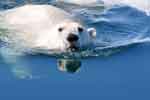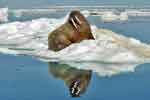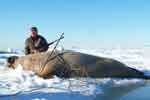About Us
Club Contacts
Junior Shooters
Upcoming Activities
Recent Activities
Member Ramblings
Books and More
Range Rules
Range Schedules
Useful Links
Website Policy

A Second Walrus Hunt in the Canadian Arctic
July 2013 -- Wes W.
(Click on the images here for a larger view.)
Note from the Webmaster. In July 2013 Wes returned to the Canadian Arctic to fulfil an earlier promise he had made. [You can also read about that earlier adventure on this site; see the Member Ramblings table of contents.]
"Why would you hunt walrus?" The question was asked and I was tempted to say something swift like "Cogito, ergo I hunt." or "Because it is there." or "If you gotta ask, then you'll never know." Instead, as I thought about the question, I began to relive the moments of this latest hunt, the anticipation of the first ideas, and the roller coaster ride that a real hunt entails.
This all started a few years back. I was involved in the training of guides in Nunavut, and a group of eager Inuit faces greeted me on our initial meeting. Here, in Igloolik, on the Melville Peninsula, I was retracing a path I had followed many years earlier. Then, I was training guides for Ecotourism, and in the bitter March cold, we were building igloos near the polynya of Fury and Hecla Strait, the holy grail of the Northwest Passage sought by many, including Sir John Franklin. The untrained eye first sees "nothing". This nothingness stretches to the horizon in all directions -- this nothingness is filled with ice and rock, and soon one begins to see the everything that is involved in this nothingness, as shapes begin to make sense. Some of the random piles of rock are there on purpose as Inukshooks, or signposts for the ice-traveller. Some warn of the dangerously thin ice that is caused by the relentless tides and currents that carve open water in the midst of this ice-vista; some promise the direction of safe travel, and one is in commemoration of a friend I knew who was dying of cancer when I was there last. I built that one years ago.
While we were there, we spoke of the promise of tourism and the possibility of employment for these guides. The historical and cultural aspects would be fine for the non-hunting ecotourists, but what of the hunters? Was there a challenge to be found here by those who search the world for the different adventures that can be found in the hunt? Since these Inuit are known as the Aivilliq people, it was not surprising when the smiling faces erupted with the happily shouted "Aivik", "Aivik". This is their term for walrus, and the walrus has been a part of their culture from the beginning. So, it was agreed that I would return the following year during July and do a combination of photography-based ecotourism, and also set up a model that would work for the visiting hunters from other cultures.
What "Global Warming"? I was there in July of 2012, and the ice was 3 weeks late in melting! Nothing is more frustrating to a wanna-be walrus hunter than to look out over hundreds of miles of sea-ice in all direction, with no open water, no hope of boat travel. As I left the community, out of the aircraft window there was solid ice visible to the horizon, right to the vague suggestion of Baffin Island's shore. Like McArthur, I vowed to return, and I would do battle with the ice the following year.
July of 2013 approached, and frantic phone calls gave ice-reports from the North. "Yes, it's melting" followed by "There's been a lull, all the ice blew back in." No matter, I was going, come Hell or high ice! The day I arrived in Hall Beach (just south of Igloolik), I saw ice again in the harbor but hope lay in the broken pieces that I saw leading to a large stretch of open water. If the wind and current didn't slam that door shut, we just might get the boats out. Maybe, we'd get stuck out there if the ice shifted later, but at least we'd be out there! (It's at times like this when my wife rolls her eyes and mutters something that sounds like "testosterone-poisoned fool", but when questioned, just smiles sweetly and says, "nothing, just said I loved you, dear."
Soon all the plans and preparations came together, and we were finally loading the boats. There would be five students and I, with all of our equipment, in two boats. We would head away from the community and make camp on a small island out in Foxe Basin. At times, the ice made a barricade that said,"You're not welcome here, try some other way." and we would. Finally, at times acting as mini-icebreakers, the boats pushed their way into a natural harbor that we would call "home" for the next few days. A granite hill made a natural "lookout", and at one time or another, each of us would climb to the top to see what the ice was doing, and it was always doing something.
It was from this vantage point that I saw the several low mounds that were on the horizon of this small island, about a half-mile from my tent. When I investigated, I found stark reminders of other walrus hunts that had taken place hundreds of years earlier. This Island was called Ugliit, a term now used by biologists to describe a place where walrus would haul-out. That's why the early walrus hunters had come here, and these were the remnants of Thule-style sod-houses that earlier Inuit had lived in. The debris contained many walrus bones, bleached white by the sun. And there in the shadows, bones covered in lichen, a human skull lay there as mute testimony to the intertwined lives of the walrus and the forebearers of the Aiviliq people who accompanied me now.
There is no darkness; and while I lay in my tent pretending it was "night", I was lulled to sleep by the slushing soft sighs and whispers of ice moving against ice. It is never still. Unseen currents move piece against piece in an endless dance; some pieces twirl in place, others push their neighbours aside in their hurry to get to some other place. And I dreamed of human skulls and walrus bones in the same dance, and always the hint of a polar bear in their midst.
Nature smiled on us. As if to make up for the previous year's ice problem, the sea was as calm as a mirror. Unbelievable! This continued for the next week, an unheard of straight run of beautiful weather. Off we went onto this mirror that floated ice on its surface. We looked hard and kept on looking, but eleven hours of travel failed to find any walrus. Over a hundred miles of travel amongst ice, and no sign of a walrus. I tried to inject some humour into the search, by telling the guides to keep an eye out for walrus tracks. They looked at me just like my wife does at times.
Back at camp, there were other things that were done to ready equipment. I had sighted in my .338 Winchester Magnum the day before, but there were always knives and harpoons to sharpen. And then too, the island was home to numerous bird species, and the arctic flowers were just beginning to bloom. The days were full and the time for sleep seemed short, and quick as a blink, we were back on the mirror-like sea searching for walrus.
At noon, we pulled the boats together for a tea-break, and to discuss where we might next look for walrus. As if on cue, not 10 yards from the boats, a huge walrus broke the mirror's surface as his basketball sized head poked up. He was all tusks and exhaled air, and sank beneath the surface to leave just a ripple to prove we weren't hallucinating. Wow!! The first glimpse of Odobenus rosmarus was just that -- a glimpse! He had returned to his search for food on the bottom, a few hundred feet below us, and he could easily stay down there for about a half-hour. This is where they skid the bottom with their tusks like sled-runners, as their whiskers feel for the clams that they can find, shuck, and consume in less than 6 seconds. The pressure differential and a powerful tongue-piston sucks the clam right out of his shell.

That renewed our hopes, for we were getting closer now! Just as in life, things seem to happen in clusters; now, it was as if we had broken the spell. The next 12 hours went by as a blur. Next we saw a polar bear, doing just what we were, searching for walrus. Although the polar bear is a formidable predator, the walrus can use his tusks as a weapon, and bears have been killed by walrus. Imagine those pointed ivory lances being driven down by 3000 pounds of force, and you can see why the bear is taking a risk. And, given that a walrus has a life-span greater than 40 years, he could amass some experience regarding how to deal with threats. Some have been known to smash into boats when they felt threatened.
Before the day was done, we would see over 30 walrus, some singly, some in small groups of three to five, but all very exciting to observe. We had done the ecotourism event, and had acquired many fine photos. Now, it was time to become a hunter once again. I glassed a group as we approached, and saw that there were 5 walrus on this small ice-floe. Initially, there seemed to be no trophy quality there, as I scanned the 3 cows and a medium bull, but one was laying in the middle, and could not be clearly identified.

We came a bit closer, and the central bull lifted its huge bulk to look back at us. The cows got nervous and launched into the sea, followed by the junior bull. The ice-floe rocked violently as 4 tons of weight shifted off of it. The head bull began to move also to keep track of the cows. I decided that I could make the vital incapacitating shot to sever the atlas and axis joint at the base of his skull. It was critical that the neck shot break the spine, since the only hope to get the bull was to drop him right where he was. Walrus do not float if they are dead. They sink as fast as a cement block tossed into the sea. This negative buoyancy allows them to stay at depth without having to fight floatation.
The crosshairs settled on the fold of his hide in the top third of its neck diameter. But this is like looking at the side of a 45 gallon fuel drum that is in motion, while aiming from a bobbing boat. The trigger was a crisp 3 pound let off that culminated in a recoil that felt like a 22. (Strange, how adrenaline minimizes peripheral things.) The bull dropped as if he had been lightning struck -- not a twitch. Simultaneously, everyone on the boat cheered with the age-old drive of the communal hunt, with a closed fisted salute to the old bull. But it wasn't over yet.
The small ice-floe was still rocking from the exodus of the other walrus, and it had a ridge of ice uplifted in the center. The angle of the ice, the rocking, and the position of the great bull's body started a slow slide into the water. Like a nuclear submarine being launched from its building dock, the bull's body gained speed as it slid down the icy ramp. This only took milliseconds, but each throat that had emitted a cheer, was now in unison saying…"OHHHH NOOOOOO!!!!" We all knew that the bull would sink to the depths and we would lose him. Hoping against hope we motored the boat quickly towards his immersion point, and saw that by some miracle, he was floating! Even Enoki, the old experienced walrus hunter said: "I have never seen one float before this, they always sink!" At the same time, I yelled to Trevor to grab the harpoon and launch it at the just-floating bull.
Time froze; I saw Trevor like a Captain Ahab, shoulder pulled way back, every muscle tensed as he poised the harpoon back at the full length of his arm's reach, balanced precariously on the small deck of the boat just ahead of the windshield. If a bobbing piece of ice hit the bow, it would be enough to knock him off balance and send him into the below-freezing salt water. With all his Inuit ancestry chanting in his bloodstream, he became the harpoon, and the fluid motion drove the hand-crafted tip deep into the bull's chest.
This was the same harpoon tip he had so carefully honed to a razor edge at the previous night's camp. This is not a simple thing, but a perfectly designed and balanced part of the Inuits' survival tool kit. The harpoon head is a separate unit originally carved from ivory, but now most-often fashioned from brass. It is designed to hold the sharpened blade, but brilliantly engineered with a curved tail that has a split. The cordage that is attached runs through a hole in the center, so that when a force attempts to pull the harpoon back through the hole it made, the split curved tail veers off to present the harpoon head sideways, so that it will not come out of its own accord.
Once again we cheered, as we towed the floating bull's carcass toward a larger ice-pan that would support our combined weight and act as a photo opportunity and as an operating table. We were still puzzled by the bull's buoyancy, until it swung its mighty head under water. It was floating because it wasn't dead! The 250 grain Nosler partition had passed under the spine by an inch or so, severing the main arteries, and the shock effect of the bullet had temporarily paralysed the walrus. Since it was still alive, the walrus had retained air in its special adaptation to life at sea, and that explained the floating that took place.
As it lifted its head for a gulp of air that would prepare it to sound to the bottom, I placed another Nosler into the neck area, this time severing the spine, as I had attempted to do the first time. In my learning curve of walrus anatomy, I had misjudged the position of the spine in that huge neck. At times like these, one recalls the adage that it is better to be lucky than good. Had I placed the first shot correctly, we would have lost the walrus because it would have sunk.

Have you ever tried pulling a truck out of a lake onto a piece of ice with only a rope and pulleys? Well, that's what this next effort seemed like. All six of us men needed all of our strength as we pulled the walrus up onto the ice. We used the boat anchor, slotted into the ice as an anchor point, while we were helped by the block and tackle. Nonetheless, it took all our combined strength and mechanical advantage to hoist the walrus up and over the ice ledge. Then we set up for the important photography lessons.
Since a visiting American hunter would not be able to import ivory to his homeland, all he would have as a memento of the hunt would be a photo. It had better be a good one! All the nuances of exposure control and professional posing of the client and the trophy needed to be examined. All the blood needed to be cleaned up, so that both the hunter and the walrus could be shown with respect. These photos are not only important for the hunter, they are important to the community, since they will be used for later promotional efforts. This is one of the few opportunities to earn a wage in this northern area.
Once the photos were completed, the tremendous work of butchering the walrus takes place. Nothing is wasted. Even the intestines are saved, cleaned and braided into chain-like links that would be eaten later. The walrus flesh is cut into great slabs of about 4 feet square. These are perforated around their circumference through the inch and a half thick skin; this allows the "rope" made from the skinned flippers to sew the slabs into big sausage-like bags that contain other organs and meat. These bags are later buried about 4 feet underground, and will be dug up 4 months later as the delicacy "Igunaq".
As I watched and took part in this collection of food that would help feed a community through the coming dark cold winter, I couldn't help but feel the ancient bond that was forged. These men worked until the sweat dripped onto the ice. They worked in unison, yet without a word needing to be spoken. Their method of where the cuts were made, and how the walrus meat was handled, had already been decided a thousand years ago. After all, these were the Aivilliq people; walrus was in their blood. Tired but happy, we returned to our camp laden with the treasures of the meat and the memories of the hunt. It was after 1:00am; we had been out for over 16 hours.
The sun was balanced on the North horizon, washing the drifting ice-floes in a golden bath of light. I could see the remnants of the early sod-houses in that same glow, and could almost imagine the sound of drumbeats and throat-singing that would have welcomed those early walrus hunters home. I had been a part of a ritual that spans time back to the last ice-age; I had memories that would last my lifetime; and, I had left meat for the elders and the single-moms of this northern community.
So, maybe the original question should be rephrased: "Why wouldn't you hunt a walrus?"
back to Table Of Contents for Member Ramblings
Warning and Disclaimer. Only the most current printed Shooting Rules and Range Standing Orders and Match Standing Orders as issued by the N.O.S.A. Executive are official and they should be read, understood, and followed. If there is any question as to interpretation of a rule, or safety of a practice, immediately ask a member of the Executive or a Range Safety Officer before placing yourself or anyone or anything else at risk. Any activity involving firearms has inherent dangers. Some contents on this website may include personal opinions and experiences or practices that should not be emulated. Everyone viewing this website, or any other website or book or magazine or pamphlet or media source, is cautioned to seek professional advice first about anything written or implied or inferred. Your safety is your personal responsibility.
Copyright © 2013 New Ontario Shooters Association. This site is copyrighted and no content may be reproduced by any means, including electronic, without written permission except for strictly personal use. Other websites wishing to post a link to this site are welcome to do so.